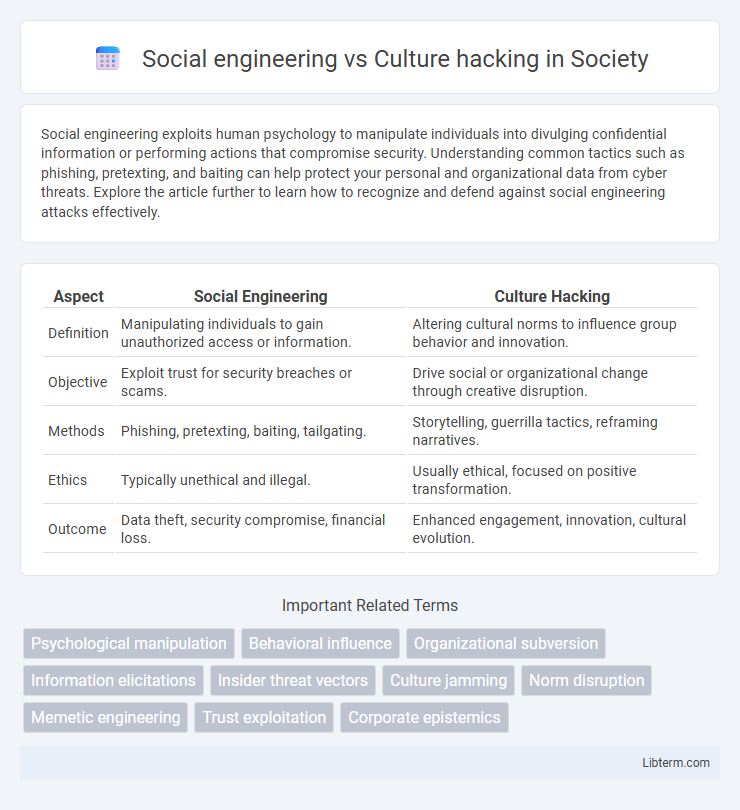Social engineering exploits human psychology to manipulate individuals into divulging confidential information or performing actions that compromise security. Understanding common tactics such as phishing, pretexting, and baiting can help protect your personal and organizational data from cyber threats. Explore the article further to learn how to recognize and defend against social engineering attacks effectively.
Table of Comparison
| Aspect | Social Engineering | Culture Hacking |
|---|---|---|
| Definition | Manipulating individuals to gain unauthorized access or information. | Altering cultural norms to influence group behavior and innovation. |
| Objective | Exploit trust for security breaches or scams. | Drive social or organizational change through creative disruption. |
| Methods | Phishing, pretexting, baiting, tailgating. | Storytelling, guerrilla tactics, reframing narratives. |
| Ethics | Typically unethical and illegal. | Usually ethical, focused on positive transformation. |
| Outcome | Data theft, security compromise, financial loss. | Enhanced engagement, innovation, cultural evolution. |
Understanding Social Engineering: Definition and Techniques
Social engineering involves manipulating individuals into divulging confidential information or performing actions that compromise security through psychological tactics like phishing, pretexting, and baiting. Techniques exploit cognitive biases and trust to bypass technical defenses, targeting human vulnerabilities rather than software. Understanding social engineering is crucial for developing effective security training and awareness programs that emphasize recognizing deceptive behaviors and safeguarding sensitive data.
Culture Hacking Explained: Concepts and Strategies
Culture hacking involves strategically influencing and reshaping group norms, beliefs, and behaviors within organizations or communities to drive change, often using creative and unconventional methods. Unlike social engineering, which primarily manipulates individuals for specific information or actions, culture hacking targets the collective mindset to foster innovation, collaboration, and adaptive transformation. Effective strategies include leveraging social networks, storytelling, and symbolic actions to embed new values and create sustainable cultural shifts.
Core Differences: Social Engineering vs. Culture Hacking
Social engineering manipulates individuals through psychological tactics to gain unauthorized access or information, focusing on exploiting human vulnerabilities. Culture hacking targets organizational culture by subtly influencing values, behaviors, and norms to drive change or achieve strategic objectives. The core difference lies in social engineering's intent to deceive for personal gain, whereas culture hacking aims to reshape collective mindsets for long-term impact.
Psychological Manipulation in Social Engineering
Social engineering exploits psychological manipulation techniques such as authority, urgency, and social proof to deceive individuals into divulging confidential information or performing actions against their interests. Culture hacking, while also targeting human behavior, primarily aims to shift organizational norms and values rather than directly manipulating individuals on a personal level. Psychological manipulation in social engineering relies heavily on cognitive biases and emotional triggers to bypass rational judgment and achieve unauthorized access.
Transforming Organizations through Culture Hacking
Culture hacking transforms organizations by strategically reshaping internal values and behaviors to foster innovation, collaboration, and adaptability. Unlike social engineering, which manipulates individuals for specific outcomes, culture hacking intentionally influences organizational norms and mindsets to achieve sustainable change. This method empowers employees to embrace new paradigms, driving long-term growth and competitive advantage through a redefined corporate culture.
Real-World Examples: Social Engineering and Culture Hacking
Social engineering exploits human psychology to manipulate individuals into divulging confidential information, exemplified by phishing scams like the 2011 Sony Pictures hack where attackers used deceptive emails to gain network access. Culture hacking, on the other hand, involves deliberately altering organizational norms and communication patterns to influence behavior, as seen in Google's open office layouts designed to foster collaboration and innovation. Both techniques impact security and productivity, with social engineering targeting vulnerabilities in human trust, while culture hacking reshapes social dynamics for strategic advantage.
Motivations Behind Social Engineering Attacks
Social engineering attacks are primarily motivated by financial gain, information theft, or unauthorized access to systems, leveraging human psychology to exploit trust and manipulate behavior. Culture hacking, on the other hand, seeks to subvert or influence organizational norms and values to achieve deeper, long-term control or disruption, often motivated by ideological or strategic goals. Understanding these differing motivations helps organizations tailor defense strategies, focusing on both immediate security threats and underlying cultural vulnerabilities.
Culture Hacking for Positive Organizational Change
Culture hacking leverages strategic interventions to reshape organizational behaviors and values by embedding positive norms that drive innovation and collaboration. Unlike traditional social engineering that exploits psychological manipulation, culture hacking focuses on authentic engagement and constructive influence to foster a resilient corporate culture. Companies implementing culture hacking often see increased employee motivation, enhanced communication flow, and accelerated adaptability to market changes.
Defending Against Social Engineering and Culture Hacking
Defending against social engineering and culture hacking requires robust cybersecurity training and fostering a security-aware organizational culture that emphasizes vigilance and critical thinking. Implementing multi-factor authentication, regular phishing simulations, and strict access controls reduces vulnerability to manipulation tactics commonly used in social engineering attacks. Encouraging open communication and continuous education on emerging threats strengthens an organization's resilience against psychological and cultural exploitation.
Future Trends: Security and Cultural Innovations
Social engineering attacks are evolving with advanced AI-driven tactics, targeting human psychology to exploit vulnerabilities in digital and physical environments. Culture hacking leverages organizational values and social norms, promoting adaptive security behaviors that foster proactive cultural innovation. Future trends emphasize integrating behavioral analytics with cultural intelligence to enhance resilience against sophisticated social manipulations and drive secure, innovative workplace ecosystems.
Social engineering Infographic

 libterm.com
libterm.com